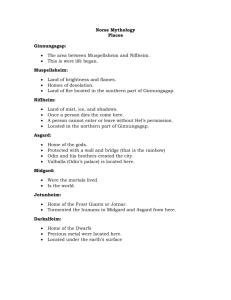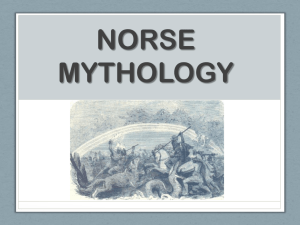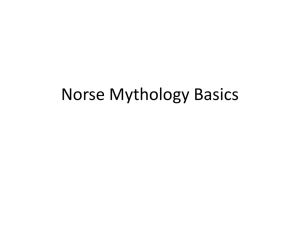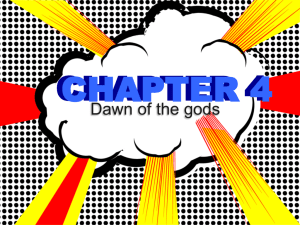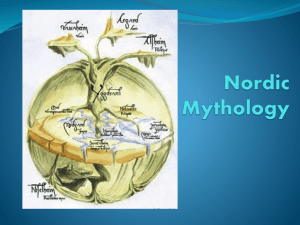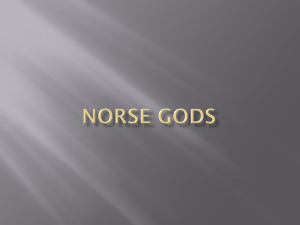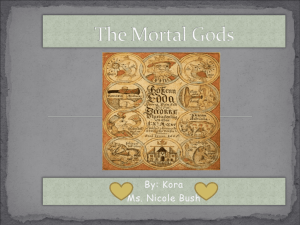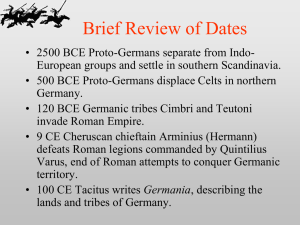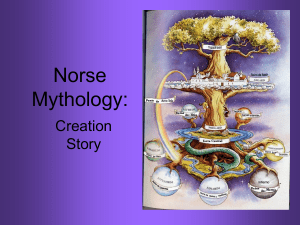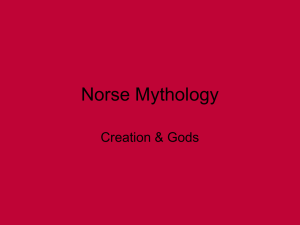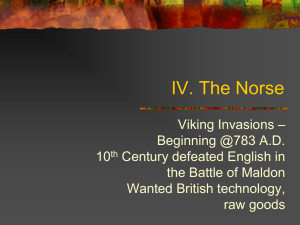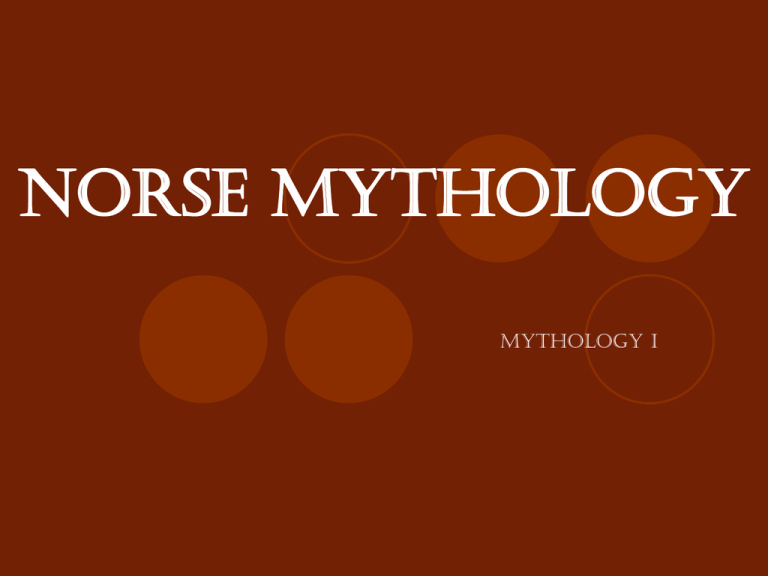
Norse Mythology
Mythology I
Background
“Norse” refers to Danes,
Norwegians, Swedes
(a.k.a. “Vikings”)
The Viking Age was 7801070 A.D.
Vikings spread from
Scandinavia to Iceland,
Greenland, Ireland,
Scotland, Russia, and
North America
Norse myths reflect the
nature of the Viking people
Sources
Elder Edda or Poetic Edda: a group of
poems by various authors that were probably
written in the tenth century
Prose Edda by Snorri Sturluson
Written around 1200 A.D.
Includes retellings of most of the poems from the
Elder Edda
Influenced by Christianity
The NORSE WORLD
YggdrasilL
“The World Tree”
World is separated into 9
realms on three levels
Most important: Asgard
(home of the gods),
Midgard (home of men),
Jotunheim (home of
giants), and Hel/Niflheim
(home of the dead)
Asgard and Midgard are
connected by Bifrost, the
rainbow bridge
GODS of the NORSE
Æsir and Vanir
Two races of gods in Norse mythology
Æsir are the more war-like gods: Odin,
Frigg, Thor, Balder and Tyr
Vanir are the more peaceful fertility gods:
Njord, sea god, and his children, Freyr and
Freyja
These clans battle, exchange hostages,
etc.
ODIN
Son of Bestla and Bor, brother of Vili and Ve
Father of Balder, Tyr, Heimdall, and others
The All-Father, God of Battle
Dwells in Valhalla, where he welcomes
courageous warriors after death
Possesses Gungnir, a great spear which he
can use to start wars
Rides Sleipner, the eight-legged horse who is
the fastest steed in the world
Thor
God of Thunder, strongest god
Son of Odin and Jord (Earth), husband of Sif
Protects Asgard, battles giants
Owns the war hammer, Mjolnir, which, when
thrown at a target, returns to the owner
Also owns a belt which boosts his strength
and a pair of special iron gloves
His chariot is drawn by two goats, which he
can eat and resurrect
Balder
God of innocence, beauty, joy, purity, and peace
Son of Odin and Frigg
Killed by a trick of Loki
Will return to rule after the end of the age
Loki
Son of giants, father of the Fenris-Wolf,
Midgard serpent, Hel, and Sleipner
Married goddess Sigyn, had two sons
Trickster hero/god, neither fully good or
bad
Able to change shape and gender
Never worshipped by men
tyr
God of single combat
and heroic glory
Once thought to be
head of the Norse
pantheon, later said to
be son of Odin
Sacrificed hand to bind
the Fenris-Wolf
frigg
Wife of Odin
Goddess of marriage,
motherhood, fertility,
love, household
management, and
domestic arts
Has the power of
prophecy but does not
tell what she knows
Is said to have woven
or spun the clouds
Freyja
Daughter of Njord, the sea god, and twin sister
of Freyr
Goddess of love, sex, beauty, prophecies and
attraction
Owned the necklace Brísingamen, and a cloak
of feathers, which let her change into any bird
Rides in chariot drawn by cats
Often desired and fought for by gods, giants,
and dwarves
freyr
Son of Njord, the sea god, and
twin brother of Freyja
Fertility god; rules over rain,
shining of the sun, and produce
of the fields
Marries a giantess, Gerd
Rides a boar with golden bristles
Has a magical sword and a
magical ship
Heimdall
Guardian of the gods
and Asgard
Blows the horn Gjall if
danger approaches
Stationed at Bifrost, the
rainbow bridge
Extremely acute senses,
does not sleep
Son of nine different
mothers
The Norns
Three women: Urd (fate),
Verdandi (being) and Skuld
(necessity)
Weave the tapestry of fates
in which each person's life
is a thread, even the gods’
Live by a root of Yggdrasill
Guard the spring of fate
The Valkyries
“Choosers of the Slain”
Always female
Give victory in battle
according to Odin’s will
Servants in Valhalla
Origin, names, and
powers differ according
to various myths
Questions?

